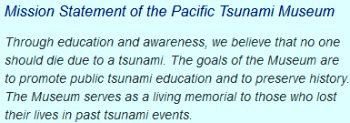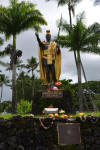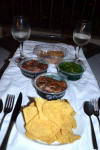Round The World and other travels
A frequent flyer's collection of trip diaries
This is: Canada & Hawaii 2016
Across to the rainy side
With the previous two diary entries concentrating on aspects of the journey, this seems like a good time to shift the focus to the second of my two key destinations for the trip. Courtesy of Bruce, let's start with a few fun facts about the USA's 50th state, together with an overview and brief history. (He ought to know something about Hawaii: like President Obama, he was born in Honolulu!)
| State of Hawaii | |||||||||||||||||||||||
  |
|
||||||||||||||||||||||
| Currently the newest member of the
union, and the only state made up entirely of islands,
Hawaii was admitted on August 21st, 1959. If polls are
correct, it seems that Puerto Rico may soon eclipse Hawaii
as the newest state, and join it as the second state made up
entirely of islands. The Aloha State is technically located in Oceania rather than the Americas, and is the northernmost island group in Polynesia. Honolulu, the only royal capital in the United States, is located on Oahu, and has a population of just under a million people. Tourism is the major industry throughout the state, followed by the US military, then agriculture. Hawaii is the only state where Asian Americans identify as the largest ethnic group, and has the lowest percentage of Caucasians (20%) of any state. The earliest known habitation of the Hawaiian Islands dates to around the year 300, most likely by Polynesian settlers from the Marquesas Islands, with a second wave of immigrants arriving from Raiatea, Tahiti and Bora Bora in the 11th century. Captain James Cook 'discovered' the islands in 1778, naming them the Sandwich Isles in honour of his benefactor John Montagu, 4th Earl of Sandwich. He met his death off the Kona coast during his second visit the following year, after a dispute with the King. Cook’s reports of this tropical paradise brought European settlers to the islands in the 1800s, and with them various Eurasian diseases to which the native population had little or no resistance. Combined with tribal wars between the island chiefs, nearly half the native population was dead by 1820, with another 20% killed off by a measles outbreak in 1850. In 1795, King Kamehameha the Great united the islands as the Kingdom of Hawaii under the House of Kamehameha, a dynasty that ruled until 1872 when King Kamehameha V died without naming an heir. A dispute ensued, and David Kalakaua was installed as king, albeit a weak one, who was eventually coerced into signing the 1887 Constitution of the Kingdom of Hawaii, stripping the monarchy of power, and creating a property qualification to vote in elections, summarily disenfranchising most Hawaiians. Upon his death in 1891, he was succeeded by his sister, Queen Liliuokalani, who was to become the last monarch of Hawaii. She was overthrown in 1893 by a group of mostly European business leaders and residents, who sought annexation by the United States, which finally happened in 1898 under President William McKinley. Hawaii remained a US Territory until achieving statehood in 1959. |

 We
got up fairly early. It was a pattern that seemed to apply to all
phases of the current trip, and which in any case made sense in a
tropical climate like Hawaii's. We skipped the hotel breakfast
(together with the sky-high charges that it would have involved) in
favour of hitting the road nice and early. Today's objective was to
visit Hilo, the county seat and largest settlement on the Big
Island. We turned left (i.e. north) onto Hwy 19 on exiting the hotel
grounds - this was the main route between Kona and Hilo and at this
stage was also the main coastal road on the Big Island's dry western
side. Continuing on this road when it swung eastwards and into the
island's hilly centre soon brought us to the little village of
Waimea and breakfast time. Our venue was a delightfully hip
independent coffee shop, for which Bruce had seen several online
recommendations. It really was a most enjoyable short stop!
We
got up fairly early. It was a pattern that seemed to apply to all
phases of the current trip, and which in any case made sense in a
tropical climate like Hawaii's. We skipped the hotel breakfast
(together with the sky-high charges that it would have involved) in
favour of hitting the road nice and early. Today's objective was to
visit Hilo, the county seat and largest settlement on the Big
Island. We turned left (i.e. north) onto Hwy 19 on exiting the hotel
grounds - this was the main route between Kona and Hilo and at this
stage was also the main coastal road on the Big Island's dry western
side. Continuing on this road when it swung eastwards and into the
island's hilly centre soon brought us to the little village of
Waimea and breakfast time. Our venue was a delightfully hip
independent coffee shop, for which Bruce had seen several online
recommendations. It really was a most enjoyable short stop!
 The
journey then continued on Hwy 19, across high ground and down to the
east coast, eventually arriving at Hilo on the cloudy, wet side of
the Big Island. It was interesting to see how frequently the
landscape changed as the journey progressed. Parched semi-desert,
black volcanic rocks with a lunar appearance, pastoral ranch
country, wild and barren moorland, and finally lush tropical
greenery - it was all there. Hilo itself turned out to be a quaint
old town, even if it did look a tad down-at-heel. I hadn't made it
to Hilo during my one previous visit to the Big Island, which had
taken place at a similar time of year in 1997. We strolled around
for a bit, with the threat of rain never far away. One particular
point of interest was the Pacific Tsunami Museum, which concentrated
on the tsunamis of 1946 and 1960 that devastated the Big Island, and
in particular Hilo.
The
journey then continued on Hwy 19, across high ground and down to the
east coast, eventually arriving at Hilo on the cloudy, wet side of
the Big Island. It was interesting to see how frequently the
landscape changed as the journey progressed. Parched semi-desert,
black volcanic rocks with a lunar appearance, pastoral ranch
country, wild and barren moorland, and finally lush tropical
greenery - it was all there. Hilo itself turned out to be a quaint
old town, even if it did look a tad down-at-heel. I hadn't made it
to Hilo during my one previous visit to the Big Island, which had
taken place at a similar time of year in 1997. We strolled around
for a bit, with the threat of rain never far away. One particular
point of interest was the Pacific Tsunami Museum, which concentrated
on the tsunamis of 1946 and 1960 that devastated the Big Island, and
in particular Hilo.
 |
 |
 |
 |
LEFT: Strolling around in downtown Hilo |
 |
| RIGHT: The bizarre and ongoing Hawaiian love affair with Spam | |||||
| RIGHT: The Pacific Tsunami Museum in Hilo |
 |
 |
 |
 |
 |
A surprisingly nice lunch followed at a quite unassuming Japanese restaurant, after which we enjoyed another short stroll through the small-town streets, this time in warm sunshine. Picking up the car again for a brief relocation, we made a quick call at the King Kamehameha statue before visiting the Japanese Garden, which was badly flooded. We had just started to cross the footbridge to Coconut Island when a ferociously heavy shower forced us to turn back and urgently seek shelter in the car.
 |
 |
 |
 |
 |
 |
 |
 |
 |
 |
 |

 Our
return to the hotel largely was largely a reverse of the morning's
drive, but with different stops. First, we made a brief call at the
little Laupahoehoe Train Museum (which became all the more abrupt
once we realised that it was closed). Later, we had a somewhat
longer stop at the Foodland store in Waimea to pick up a
selection of poke and other items, along with some wine.
Yes, this evening we would be having one of Bruce's famous in-room
picnics to end the day!
Our
return to the hotel largely was largely a reverse of the morning's
drive, but with different stops. First, we made a brief call at the
little Laupahoehoe Train Museum (which became all the more abrupt
once we realised that it was closed). Later, we had a somewhat
longer stop at the Foodland store in Waimea to pick up a
selection of poke and other items, along with some wine.
Yes, this evening we would be having one of Bruce's famous in-room
picnics to end the day!
Back at base, there was still time for a visit to the beach, a Mai Tai at the beach bar and a rest in the room before the said picnic took place on our private balcony. Later still, as I settled down for the night, I had become aware that twin hurricanes Madeline and Lester were in the general area, but didn't pay too much attention to the reports at this stage.